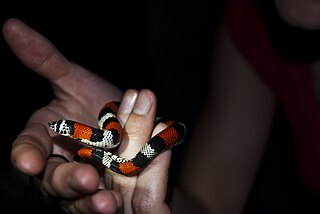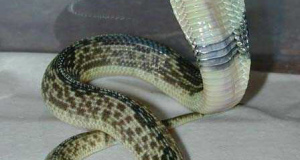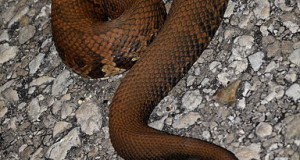The term “rear fanged” is applied to a variety of unrelated snakes that possess a venom-producing gland and 1-3 enlarged, grooved maxillary teeth in the rear of the mouth. We do not yet know how many species possess these venom-conducting teeth (“rear fangs”), but evidence indicates that snake venom evolved some 60 million years ago – before non-venomous snakes came into being. Therefore, all present day species may have evolved from venomous ancestors, and may possess at least the traces of venom glands. The rear-fanged snakebites I’ve dealt with in the course of my career have elicited only mild reactions. Some rear-fanged species, however, have caused fatalities – two very “famous” fatalities, in fact (please see below).
Snakes Best Kept in Zoos
As individual sensitivities and other factors can greatly affect one’s reaction to a bite, even “mildly venomous” species must be considered as potentially dangerous. A lifetime of experience as a zookeeper and herpetologist has taught me that it is impossible for a private snake owner to adequately prepare for or treat a venomous snakebite at home, or, prior to a bite, to arrange for treatment in a hospital.
Until we learn more about them, rear fanged snakes are best considered as suitable for display in zoos rather than private collections. Tentacled Snakes (Erpeton tentaculatum) and certain others may be an exception, but I advise consulting a herpetologist and an experienced medical doctor if you feel compelled to acquire a rear-fanged snake of any species.
Overview
Rear fanged snakes are classified in the huge family Colubridae (the “Typical Snakes”), but are not necessarily closely-related to one another. The term is applied to a variety of species that possess the venom-producing Duvernoy’s Gland. One, two, or three of the maxillary teeth in the rear of the mouth are enlarged and bear grooves on their front surfaces. Venom released by the Duvernoy’s Gland flows down these grooves and into a prey animal or foe. A period of “chewing”, in the manner of cobras and other Elapids, may be necessary in order to fully discharge the venom.
This method of introducing toxins into a wound is rather ineffective when compared to that employed by rattlesnakes and other Viperids. Also, many rear fanged species produce venom that is most or only effective against the specific animals upon which they feed. Therefore, not all present a threat to people.
However, much remains to be learned. For example, Boomslangs (Dispholidus typus) and Twig Snakes (Thelotornis kirtlandi) were not widely believed to be dangerous until each killed a prominent herpetologist! (I use “widely” because both were feared by local people).
Size
At an adult size of 8 inches, North and South America’s Crowned Snakes, (Tantilla spp.), are the smallest rear fanged species known.
Widely-distributed through much of Southeast Asia, the 7-foot-long Mangrove Snake (Boiga dendrophila), is the largest. This spectacular snake’s size and striking coloration render it much desired in the trade, and many are held in private collections. Those I’ve kept in zoos have remained high-strung and difficult to work with. Fatalities have not, as far as I know, been attributed to their bites, but large individuals can store up a substantial quantity of venom – I’d leave these beauties alone!
Diet
Many rear fanged snakes have evolved toxins that specifically target reptiles and amphibians, and may specialize in hunting lizards (Mexican Vine Snake, Oxybelis aenus), frogs and toads (Malagasy Giant Hog-Nosed Snake, Lioheterodon madagascariensis) or fish (Tentacled Snake, Erpeton tentaculatum).
Others, such as the Mangrove Snake (Boiga dendrophila), are generalists that consume a variety of creatures, including birds and mammals. The tiny Crowned Snakes, Tantilla spp., limit their diet to earthworms, centipedes, beetle grubs, and other invertebrates.
“Harmless Snakes” with Venom
Recent research has shown that 2,000 or more snake species, many considered “harmless”, likely produce true venom. Most do not have efficient rear fangs, and produce toxins that pose no danger to people, but this does point out the need for caution and research.
Further Reading
Venomous Snakebites: My Experiences and a New Study
The USA’s Most Dangerous Snake?
 That Reptile Blog – Reptile, Amphibian and Exotic Pet Care and Information
That Reptile Blog – Reptile, Amphibian and Exotic Pet Care and Information










Frank, first let me say this is again another great article. I was or am under the impression that Duvernoy’s Gland is no longer used as according to Dr. Bryan Grieg Fry of Venomdoc.com it has now been understood that the Duvernoys gland is now an abandonded term due to the recent works in reptile toxins. I would be interested to hear your thoughts on this. I’ve also heard and read that Garter Snakes can and do cause symptoms in humans albeit rare. Do you have experience in that area?
Hi John,
I hope all is well. Thanks for the kind words and heads-up. I have not seen anything on point published in the major journals, and AMNH still using term in recent temporary exhibits, but will keep an eye out…common for similar proposals etc to float around for a time before being decided on or definitively accepted. Certainly anything from Dr Fry should be given close attention.
I’ve seen reports on a huge array of reactions being caused by a great many species considered harmless…individual sensitivities very impt, and of course a bite from any creature transfers a multitude of bacteria and other micro-organism species, which can play a role. Some of the Asian species sold as “Chinese garter snakes” etc. do elicit fairly strong reactions in many people. Best regards, Frank
How do you feel about hognose snakes? These are commonly sold in pet shops and reptile shows but for the most part are extremely docile and make wonderful pets (we adore our hognose). Of course they may be an exception to the rule … Side note- I’ve started seeing Mexican Beaded Lizards for sale at CA reptile shows… Probably also not a good idea.
Rock on Frank! Keep up the great articles!
Hi Frank.
Here in Japan, there is a rear-fanged snake, the tiger keelback (Rhabdophis tigrinus), which was not known to be venomous until the early 1970’s. It has since accounted for several fatal bites. This snake also has an external venom gland that produces a defensive venom in the manner of toads.
Conversely, the Japanese keelback (Amphiesma vibakari vibakari) was traditionally believed to be deadly, even though it posesses no venom glands.
Hello Andrew,
Thanks very much for the interesting post. Several Rhabdophis species shoed up in the US trade in the mid-80’s (I cannot recall species now) and some severe reactions to bites resulted.
best, Frank
Hello Chris,
Thanks for the kind words!
Western hognose snakes have not caused any notable reactions as far as I know, and are reluctant to bite in most cases. I haven’t looked into the properties of their venom.
Easterns are toad specialists and not generally kept. They produce a venom that seems to target toads specifically.
Bearded lizards are venomous but are treated very casually by keepers, as are Gila Monsters. They should not be kept outside of zoos. There is no antivenin available and contrary to popular belief, gila bites have caused fatalities (I haven’t looked nto beaded bites, but likely the same). Please see this article on gilas.
Best regards, Frank
Frank, my issue with your article is that you make a blanket statement that Rear Fanged don’t make good pets. This not only includes the range of potential danger from the snake, but the variations of skills and abilities of the keeper.
“Rear-Fanged” ranges from Hognose snakes to Boomslangs. You might as well say “Constrictors” don’t make good pets as that encompasses just as much range of potential risk for the keeper with House snakes to Anacondas. Some can kill, some can’t, some could cause minor problems or reactions.
Rear-fanged snakes do require special consideration as a buyer or seller. I won’t sell to anyone with a history of significant allergic reactions or one who doesn’t have significant experience with keeping captive snakes.
My rear-fanged snakes that I have kept have been fantastic pets, but I’ve never bothered with twig snakes or boomslangs… because that would be silly to think they are similar in risk to Mussuranas or Hognose snakes.
Hello,
Please note: the remarks in your comment that were personal in nature have been deleted; in the future, comments containing such will not be posted at all.
Unfortunately, sellers are not in a position to evaluate a buyer’s medical history, etc.
Re hognose and other snakes that have not caused any health concerns as far as I know, please see the article excerpts below, thank you:
“The rear-fanged snakebites I’ve dealt with in the course of my career have elicited only mild reactions. Some rear-fanged species, however, have caused fatalities”
“Until we learn more about them, rear fanged snakes are best considered as suitable for display in zoos rather than private collections. Tentacled Snakes (Erpeton tentaculatum) and certain others may be an exception, but I advise consulting a herpetologist and an experienced medical doctor if you feel compelled to acquire a rear-fanged snake of any species”.
Great to see this topic get some coverage. Dr. Fry has been great to share information on which species he regards as the most likely to be dangerous, but my understanding is there are a lot of species for which not much information exists yet. I also read a book by a guy named Weinstein which had some good information in it, too. I am picking up some rear fanged snakes next year but its a species that is known to be totally harmless and not even produce local reactions so we’re talking safer than a garter snake!
Thanks, Kevin. You can’t go wrong following Dr. Fry’s advice. Yes, still a great deal to learn..about venom glands in lizards also (even bearded dragons have evidence of venom glands that must have been utilized early on in their evolution!). Enjoy and please keep me posted, frank